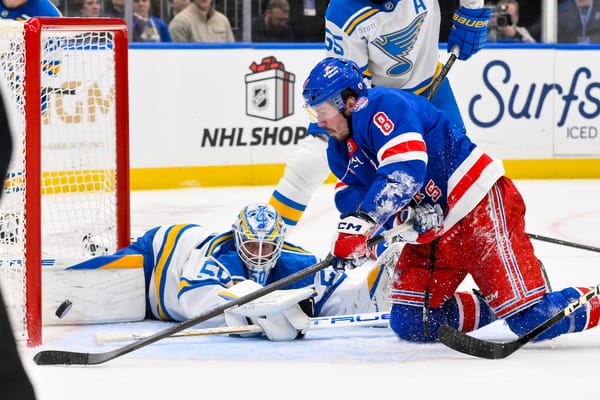Taking a Look at Neal Pionk’s Impact on the Power Play
It’s no secret that the jury’s still out on Neal Pionk. Though his flashy point totals have been a welcomed surprise, there’s still the issue of his subpar underlying numbers. Many angles of his value have already been covered (with Shayna just recently adding her own thoughts at the Athletic). I wanted to take a closer look at Pionk’s impact on the power play though, a crucial component of his game this season that has yet to be covered extensively. How has Pionk performed in his new spot on the first power play unit?
Basic Stats
The Rangers have done a relatively good job of scoring with Pionk on the ice, as he has the highest 5v4 GF/60 out of all Ranger defensemen. However, similar to his even-strength play, Pionk’s underlying numbers leave a lot to be desired. Out of all the Rangers defenders who get regular power play time (Pionk, Shattenkirk, and DeAngelo), he has the lowest SCF/60 and CF/60 on the power play by a significant margin. While Shattenkirk and DeAngelo have a CF/60 over 100 (107.5 and 104.1 respectively), Pionk’s CF/60 is only 77.2.
His SCF/60 rate is nearly as bad, clocking in at 31.99 compared to Shattenkirk’s 46.1 and Pionk’s 42.4 SCF/60. Out of the trio of defenders, Pionk’s also the only one to have a negative RelSCF/60 rating (third to last on the entire team ahead of only Adam McQuaid and Marc Staal). This is all with the added benefit of better linemates, as Pionk has spent most of his 5v4 ice time with the first unit (composed of the Rangers top forwards like Mika Zibanejad and Matts Zuccarello).
In-Depth Stats
Those stats don’t tell the whole story though, only capturing Pionk’s shot metrics. Throughout the season I’ve been collecting microstats on the Rangers power playand with them we compare how the Rangers have performed with Pionk on and off the ice. I’ve broken the stats up into two general parts, with stats pertaining to entering the zone in a separate table from stats measuring in-zone play.
Entry Stats
| Situation | Carry% | Pass% | Dump% | Center% | Left% | Right% | # of passes |
|---|---|---|---|---|---|---|---|
| With Pionk | 39.40% | 30.30% | 30.30% | 45.50% | 30.30% | 24.20% | 0.97 |
| Without Pionk | 61.50% | 15.40% | 23.10% | 44.20% | 38.50% | 17.30% | 1.04 |
Carry% - Percentage of entries where the puck was carried into the zone
Pass% - Percentage of entries where the puck was passed into the zone
Dump% - Percentage of entries where the puck was dumped into the zone
Center% - Percentage of entries where the puck entered through the center of the ice
Left% - Percentage of entries where the puck entered through the left side of the ice
Right% - Percentage of entries where the puck entered through the right side of the ice
# of passes - Average number of passes completed before entering the zone
The Rangers entry locations don’t change much depending on Pionk being on or off the ice, as they have entered through the center at an almost identical rate. Entries are slightly more common on the right side with Pionk playing but not by a huge amount. The number of passes roughly equivalent too, as entries with and without Pionk have only been composed of an average of one pass.
One noticeable difference though is that with Pionk on the ice, the Rangers carry the puck over the offensive blue line a lot less. With Pionk on the ice, the Rangers have only attempted to carry the puck in 39.4%, compared to 61.5% of the time when Pionk’s off the ice. The Rangers have also dumped the puck in the offensive zone much more frequently, dumping the puck 30.3% of the time with Pionk on the ice compared to 23.1% without him.
I hypothesize that this difference is largely due to Pionk’s tendency to skate up through the neutral zone himself and dump the puck in deep when running through the Rangers Dallas Cut formation. Below is an example of Pionk doing it against the
It’s not a terrible strategy, especially when you have Chris Kreider skating onto the puck (Kreider does manage to beat the defender to the puck). However, it contributes to Pionk’s lower controlled rate of entries, which we’ll get into right now.
Entry Stats
| SItuation | Success% | Controlled% | Drop Pass% | Dallas Cut% | Three Back% | Single Swing% | Random% |
|---|---|---|---|---|---|---|---|
| With Pionk | 81.80% | 54.50% | 30.30% | 30.30% | 30.30% | 0% | 15.20% |
| Without Pionk | 92.30% | 61.50% | 11.80% | 31.40% | 9.80% | 5.90% | 23.50% |
Success% - Percentage of zone entry attempts where the puck successfully crossed the offensive blueline
Controlled% - Percentage of zone entries where the puck was under control of the attacking team when entering
Drop Pass% - Percentage of entry attempts where the Rangers were lined up in the Drop Pass formation
Dallas Cut% - Percentage of entry attempts where the Rangers were lined up in the Dallas Cut formation
Three Back% - Percentage of entry attempts where the Rangers were lined up in the Three Back formation
Single Swing% - Percentage of entry attempts where the Rangers were lined up in the Single Swing formation
Random% - Percentage of entry attempts where the Rangers were not lined up in any specific formation
With Pionk on the ice, the Rangers have only entered the zone with control 54.5% of the time. Without him, they’re controlled entry percentage rises to 61.5%. This is along with the lower success percentage the Rangers have with Pionk on the ice too, as the Rangers have entered the zone successfully 92.3% of the time without Pionk compared to 81.8% with him.
This is a much bigger mark against Pionk, as zone entry success is an important part of generating shot attempts and in general successful power plays. Controlled zone entries are also much more likely to lead to shot attempts, making them (generally) preferable to uncontrolled entries. Pionk doesn’t fare well in either of these categories though, with the team performing much worse with Pionk being involved.
On a more positive note though, the Rangers have had a lower proportion of “Random” entries with Pionk on the ice, hinting at the idea that the Rangers have had a higher proportion of more structured entries. Even though there isn’t as much literature on the importance of structure in zone entries as opposed to in-zone formations, intuitively you can think imagine the benefits a more structured entry would have compared to random entries where the attacking players aren’t on the same page.
Speaking of entry structure, it’s also interesting to see the distribution of entry styles with and without Pionk. The Rangers have shown a stronger preference for the drop pass when Pionk’s on the ice, using it almost three times as often compared to when he’s off the ice. This could be indicative of a larger idea of using the drop pass for the first unit and non-drop passes for the second but either way it highlights Pionk’s different usage compared to the other defenders (who have not been asked to quarterback the drop pass as frequently).
In-Zone Stats
| Situation | InForm% | Time in Zone | Shot Attempts | Scoring Chances | Shots |
|---|---|---|---|---|---|
| With Pionk | 43.20% | 11.2 s | 0.51 | 0.19 | 0.26 |
| Without Pionk | 34.50% | 13 s | 0.6 | 0.23 | 0.29 |
InForm% - The percentage of instances where the Rangers successfully got into formation when attempting to get into formation
Time in Zone - Average time spent in the offensive zone per entry
Shot Attempts - Average shot attempts per entry
Scoring Chances - Average scoring chances per entry
Shots - Average shots per entry
As far as in-zone stats go, Pionk fares a little better here. With him on the ice the Rangers have had a much better InForm%, getting into their desired power play formation 43.2% of the time compared to only 34.5%. The team has spent less average time in the offensive zone time per entry but the predictive value of that stat is still up for debate (maybe something I can specifically look at in a future article).
However, as one might have guessed based on Pionk’s poor individual shot metrics, the Rangers fare better in most shot-based categories with Pionk off the ice. The Rangers have averaged slightly more shot attempts, scoring chances, and total shots per entry without Pionk than with him. They’re not huge differences but the fact remains that the Rangers have gotten off more shots per entry when he’s not on the ice.
Conclusions
Overall, it’s difficult to say how much value Pionk has provided to the Rangers power play as there are both positives and benefits. If anything, I would put more weight into some of the entry stats as they would be probably be a much better indicator of the effect Pionk’s had on the actual play. Where there are four other skaters contributing to shots and getting into form, Pionk is usually the one directly starting the entry attempt.
It’s also hard to isolate Pionk’s specific contributions because of the proportion of time he’s spent on the first unit. Almost all of his power play time has spent spent with the same group of players, so do these stats show the difference in the Rangers performance with Pionk on and off the ice or with the first unit on or off the ice?
Still, it’s interesting to see more information, especially when trying to evaluate if it’s the right decision to give Pionk all this ice time on the first unit (over Shattenkirk or DeAngelo). Anecdotally, I would say he’s not the best power play quarterback a team could ask for but he’s been serviceable. He’s prone to some mistakes and sometimes I question his decision making but he’s good at point shots through traffic and has good offensive instincts.
Overall, Pionk hasn’t done a great job on the first unit but he’s been serviceable. The Rangers are at a place where they can experiment and give their younger players the opportunity to try new roles. I didn’t expect Pionk to end up being the Rangers leading defensemen in power play time but am excited to see if he can continue to get better and improve on several key aspects as the season goes on.




